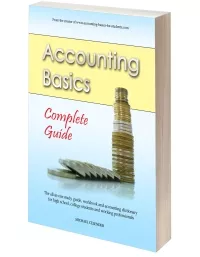Other Accounting Reports
Previous lesson: Cash Flow Statement Example
Next lesson: What is Inventory?
There are various other accounting reports (besides the four types of financial statements) that a bookkeeper or accountant can produce, that allow for greater control over a business and its activities.
Be sure to check your understanding of this lesson by taking the quiz in the Test Yourself! section further below. And right at the bottom of the page, more questions on the topic submitted by fellow students.
Note that the reports below are not part of the four financial statements. They are accounting reports for internal use within a business.
Debtor's Analysis
The debtor’s analysis indicates the value and age of each of the debts owed to your business. The debtor’s analysis should reveal who are one’s biggest or oldest debtors (accounts receivable) at a glance.
Here is a sample debtor's analysis:
Most businesses allow 30 days of credit for a debtor to pay. The "current" column would reflect accounts that are less than 30 days old (i.e. debts incurred within the current month). All other debts are past due and would need to be followed up. Debts of "60 days" or "90+ days" are seriously overdue.
Note that debts that have not been paid on time are referred to as "past due."
The debtor's analysis should be compared to the debtors control account (in the general ledger) and to the total of the individual debtor T-accounts in the debtors ledger.
In the same way that a debtor's analysis shows the oldest debts owed to one's business, a creditor’s analysis can quickly reveal to whom one’s oldest debts are owed.
This creditor's analysis should be compared to the creditor’s control account (in the general ledger) and to the total of the creditor T-accounts in the creditors ledger.
Creditors should generally be paid by age – i.e. pay the oldest ones first.
Asset Register
An asset register is a list of every asset in the business as well as details regarding each of the assets.
The asset numbers are unique codes or tags to identify each asset.
The carrying amount of an asset is the amount at which we carry it in the accounting books – in other words, our current estimated value for the asset.
The carrying amount is often different to the original cost price of a non-current (long-term) asset due to depreciation - the decrease in the value of an asset over time.
(FYI depreciation and carrying amounts are not covered in detail on this site, only in our basic accounting books)
The carrying amounts in the asset register can be compared to the balances of non-current asset accounts in the ledger. The values of these assets in the asset register (carrying amounts) should correspond with the balances of the T-accounts for these same assets. In other words, if the asset register, for example, shows three machines worth $30,000 each, then the machinery accounts in the general ledger should show a total carrying amount of $90,000.
Other details can be included in the asset register, such as the location of each asset, the estimated remaining useful life of the asset (for example, you expect your computer to last another 3 years before needing to replace it), whether the asset is insured or not, and who the asset’s insurer is.
Stock-Holding List / Inventory List
Another list that should be regularly compiled is a stock-holding list or inventory list, which is a list of all the stock or inventory that your business holds (i.e. goods held for sale), including types of stock and their respective values.
Like the asset register, the stock-holding or inventory list could also include an individual code for each inventory item, as well as any details the business may want to keep in its records such as the year, make, model or color of the inventory item.
And like the asset register, the values of the assets in the stock-holding list should also be regularly compared to the total of the inventory T-account.
Conclusion
There are actually various types of accounting reports and accounting lists one can prepare in addition to the ones listed above.
For example, one can prepare a list of cash or bank types (such as different bank account balances, petty cash, etc.). The bank T-account could then be regularly reconciled to this list of accounts at the bank.
But the reports highlighted above are common reports used within a business.
These reports provide an accountant or manager with useful information about a business's operations. Regular comparisons of these reports to your ledger accounts also allows one to quickly recognize and rectify any errors, omissions and problems.
Test Yourself!
Before you start, I would recommend to time yourself to make sure that you not only get the questions right but are completing them at the right speed.
Difficulty Rating:
Beginner
Quiz length:
6 questions
Time limit:
7 minutes
Important: The solution sheet on the following page only shows the solutions and not whether you got each of the questions right or wrong. So before you start, get yourself a piece of paper and a pen to write down your answers. Once you're done with the quiz and writing down your answers, click the Check Your Answers button at the bottom and you'll be taken to our page of solutions.
Good luck!
That's it for our tutorial on other accounting reports.
What did you think of this lesson? Do you have any questions on the topic or on related topics? If so, have your say by adding a comment at the bottom of the page.
If you feel good up to this point, please continue on to the next chapter on this site, where we'll cover trading businesses and inventory.
Return from Other Accounting Reports to The Four Types of Financial Statements
Return from Other Accounting Reports to Home Page
Stay up to date with ABfS!
Follow us on Facebook:
Previous lesson: Cash Flow Statement Example
Next lesson: What is Inventory?
Questions Relating to This Lesson
Click below to see questions and exercises on this same topic from other visitors to this page... (if there is no published solution to the question/exercise, then try and solve it yourself)
Time Difference in Finance
Q: What is time difference in finance?
Stock Taking And Security
Q: I wanna know how to prepare a stock taking and security report for a school project. In particular how to enter agreements with suppliers, authorization …
Bank Reconciliation Questions:
What is a Bank Reconciliation and the Bank Reconciliation Process?
Q: When talking about a bank reconciliation, what exactly are we talking about?
A: A bank reconciliation is the comparison of the bank statement …
Accounts Receivable Aging Data
Q: What do you understand from the accounts receivable aging data? What does it refer to? Can you provide an example on aging data?
A: Aging data …
© Copyright 2009-2023 Michael Celender. All Rights Reserved.
Click here for Privacy Policy.








Comments
Have your say about what you just read! Leave me a comment in the box below.